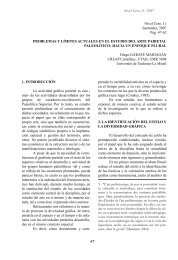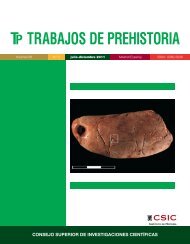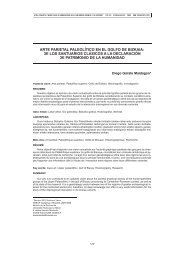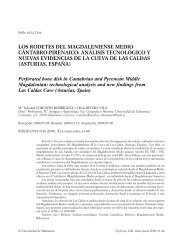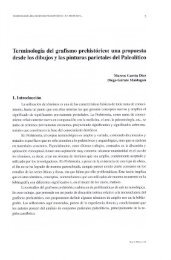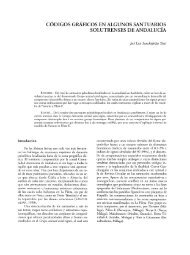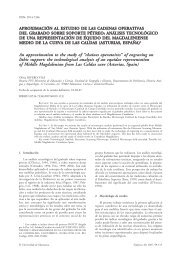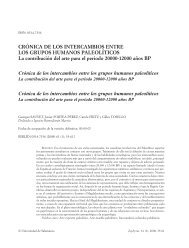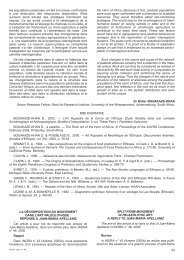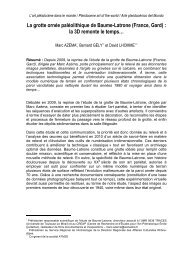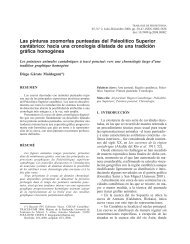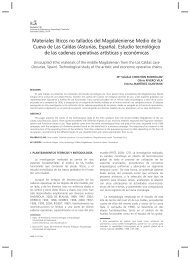Maya von Czerniewicz, Tilman Lenssen-Erz & Jörg ... - creap
Maya von Czerniewicz, Tilman Lenssen-Erz & Jörg ... - creap
Maya von Czerniewicz, Tilman Lenssen-Erz & Jörg ... - creap
Create successful ePaper yourself
Turn your PDF publications into a flip-book with our unique Google optimized e-Paper software.
PRELIMINARY INVESTIGATIONS IN THE DJEBEL UWEINAT REGION,<br />
LIBYAN DESERT<br />
<strong>Maya</strong> <strong>von</strong> <strong>Czerniewicz</strong>, <strong>Tilman</strong> <strong>Lenssen</strong>-<strong>Erz</strong> & <strong>Jörg</strong> Linstädter<br />
<strong>Maya</strong> <strong>von</strong> <strong>Czerniewicz</strong> / <strong>Tilman</strong> <strong>Lenssen</strong>-<strong>Erz</strong> / <strong>Jörg</strong> Linstädter<br />
SFB 389 “ACACIA”<br />
Universität zu Köln<br />
Forschungsstelle Afrika<br />
Jennerstr. 8<br />
50823 Köln<br />
Germany<br />
Abstract<br />
Over the last hundred years the Djebel Uweinat was the<br />
objective of several expeditions, most of them being driven<br />
by the intention to find new rock art sites. These explorers<br />
mostly stayed at the base of the mountain where the majority<br />
of the currently known rock art sites were found. During<br />
their two recent visits, the members of the ACACIA team<br />
focused their interest on the upper part of the Uweinat and<br />
on its smaller, mostly neglected neighbouring mountain, the<br />
Djebel Arkenu.<br />
In the upper part of the Djebel Uweinat artefacts and some<br />
stone arrangements were found. While no rock art sites were<br />
spotted in the upper part, we discuss the function of stone<br />
arrangements and rock art from the lower reaches in view<br />
of the semiotic processes in which they may have operated.<br />
The presentation of the rock art sites found at Djebel Arkenu<br />
will also be fitted into an overview of how we interpret the<br />
cognitive map of people who used to live in the environment<br />
of the two mountains. Furthermore, some background information<br />
concerning the landmarking function of the archaeological<br />
finds is given which could be a useful indicator of the<br />
character of mobility as well as of perception of landscape<br />
among prehistoric people.<br />
Keywords: Libya, landscape, semiotic processes, stone structures, rock art, pottery.<br />
E-mail: fst.afrika@uni-koeln.de<br />
Résumé<br />
Durant les deux siècles précédents, le massif du Djebel<br />
Uweinat a fait l’objet de plusieurs expéditions, dont la plupart<br />
avait pour but la découverte de nouveaux sites d’art<br />
rupestre. Ces explorateurs s’étaient jusqu’alors presque<br />
essentiellement limités au pied des reliefs, là où se trouvent<br />
d’ailleurs la majorité des sites rupestres connus actuellement.<br />
Au cours de leurs deux dernières visites, les membres<br />
de l’équipe ACACIA, ont concentrés leur intérêt sur la partie<br />
supérieure du Djebel Uweinat ainsi que dans un petit massif<br />
montagneux voisin souvent négligé, le Djebel Arkenu.<br />
Dans la partie supérieure du Djebel Uweinat, des artefacts<br />
ainsi que des arrangements organisés de pierres ont été<br />
découverts. Dans la partie supérieure, seuls des arrangements<br />
de pierres ont été trouvés, l’art rupestre n’étant présent<br />
que dans la partie inférieure. Par conséquent, ces différences<br />
seront discutées en terme de processus sémiotiques.<br />
Les sites d’art rupestre du Djebel Arkenu seront placés dans<br />
le contexte d’une carte cognitive d’une population qui vivait<br />
dans l’environnement des deux montagnes. De plus, quelques<br />
informations de base concernant la fonction des trouvailles<br />
archéologiques qui marquent le paysage et donc qui<br />
sont interprétés comme des indicateurs de la mobilité ainsi<br />
que de la perception de l’environnement par les peuples préhistoriques.<br />
Journal of African Archaeology Vol. 2 (1), 2004, pp. 81-96 81
82<br />
Introduction<br />
The Djebel Uweinat and its smaller neighbour<br />
Djebel Arkenu are two mountains which rise over the<br />
flat plain southeast of the Libyan oasis Kufra (Fig. 1).<br />
The Djebel Uweinat forms a landmark where the frontiers<br />
of Libya, Egypt and the Sudan meet. The largest,<br />
western part of the mountain belongs to the Libyan<br />
side, whereas the Sudanese (southeast) and Egyptian<br />
parts (northeast) are much smaller. The highest peak<br />
reaches about 1900 meters above sea level. Deep wadis,<br />
the so-called Karkurs, cut into the almost circular shaped<br />
mountain. On the northern and western side are located<br />
the Karkurs Hamid, Idriss and Ibrahim, on the eastern<br />
side the Karkur Murr and Karkur Talh. There are permanent<br />
springs at Ain Doua, Ain Zuweia and Ain Murr.<br />
Their existence seems to have induced the mountain’s<br />
name since the Arabic word ”‘Uwênât“ can be translated<br />
as “the small fountains” (SCHIFFERS 1973: 423).<br />
Geologically the Djebel Uweinat consists of two<br />
parts: the western part is composed of circles of<br />
praecambric layers; in the eastern part sandstone-pillars<br />
dominate the outer appearance of the mountain<br />
(SCHIFFERS 1973: 426).<br />
Beginning from the early 1920ies, the Djebel<br />
Uweinat was the objective of numerous expeditions<br />
from different countries. Before going into detail of<br />
two recent visits of members of the collaborative research<br />
centre SFB 389 ACACIA/University of Cologne,<br />
Germany, to the Libyan side of the Uweinat, the history<br />
of research of this area will be outlined.<br />
Historical background<br />
Looking for a direct way from Ouadai to the Mediterranean<br />
coast, a Majabri Arab from Jalo called<br />
Shehaymah, passed by a mountain with two rock wells<br />
at its foot. This happened around 1809 or 1810 and it is<br />
very likely that his description of the “Gebel en Nari”,<br />
the “mountain in flames”, corresponds to the mountain<br />
nowadays known as the Djebel Uweinat (SHAW<br />
1934: 64-65).<br />
Ahmed Hassanein Bey, an Egyptian diplomat and<br />
explorer, was the first to report in detail in 1924 about<br />
the Djebel Uweinat and its neighbouring smaller granite<br />
outcrop, the Djebel Arkenu (HASSANEIN BEY 1924:<br />
354). In his travel documents he mentioned rock engravings<br />
at the Karkur Ibrahim, on the western side of<br />
the Uweinat, which led him to wonder: “There are no<br />
M. v. <strong>Czerniewicz</strong>, T. <strong>Lenssen</strong>-<strong>Erz</strong> & J. Linstädter<br />
Journal of African Archaeology Vol. 2 (1), 2004<br />
giraffes in this part of the country now, nor can they<br />
live in similar desert country anywhere. Also there are<br />
no camels among the carvings, and one cannot penetrate<br />
to this oasis now except with camels. Did the<br />
men who made these pictures know the giraffe and not<br />
the camel?” (HASSANEIN BEY 1924: 355-356) With these<br />
words he indicates that he was well aware of the antiquity<br />
of the pictures.<br />
After the description of these two “lost oases”,<br />
until then only believed to exist far away in the west<br />
beyond the farthest known Egyptian oasis (WILKINSON<br />
1837; BAGNOLD 1937: 265), the Egyptian Prince Hussein<br />
Kemal el-Dine, who found his passion in exploring the<br />
desert, started an expedition towards the Gilf Kebir and<br />
the Uweinat with Citroen cars in 1925 and 1926. The<br />
prince published his rock art finds of the Karkur Talh in<br />
two volumes (KEMAL EL-DINE 1928; KEMAL EL-DINE &<br />
BREUIL 1928).<br />
The next explorer who found his way to the Uweinat<br />
was the English Major R. A. Bagnold. After Bagnold’s<br />
first short passing-by of the Uweinat in 1930 (BAGNOLD<br />
1931: 29-31) he returned in 1932 to focus his and his<br />
colleagues’ interest on the rock art of Karkur Talh<br />
(BAGNOLD 1933: 106; SHAW 1934).<br />
The Hungarian discoverer Almasy was lured by<br />
the secrets of the Libyan Desert. His passion for the<br />
desert was combined with his abilities as an excellent<br />
driver and pilot and so he could make use of these new<br />
technologies for his expeditions to the Gilf Kebir and<br />
the Uweinat, among others. When Almasy came to Ain<br />
Doua in May 1933, at the southern fringe of the Djebel<br />
Uweinat, he met an Italian topographical mission, including<br />
L. di Caporiacco with whom a wide dispute<br />
about the findings of Ain Doua unfolded. According<br />
to Almasy’s description it was his driver who found<br />
the first rock paintings at Ain Doua and together they<br />
located a dozen rock art sites before passing this information<br />
to di Caporiacco (ALMASY 1936: 73-75, 1939:<br />
140). Di Caporiacco and also the German researcher<br />
Frobenius, who came to Ain Doua together with Almasy<br />
in October of 1933, claimed in their articles (CAPORIACCO<br />
1933, 1934 a,b; CAPORIACCO & GRAZIOSI 1934) and in oral<br />
communications (ALMASY 1936: 73) the discovery for<br />
themselves – a conflict which remains unresolved until<br />
today.<br />
Despite these “quarrels”, the expedition of<br />
Frobenius, with the aim to record the rock art and archaeology<br />
of the Libyan Desert, led to a publication<br />
by Rhotert, an expedition’s participant, in which he
Preliminary investigation in the Djebel Uweinat region, Libyan Desert<br />
Fig. 1. The Djebel Uweinat. The eastern sandstone-massive and the almost round western magmatic<br />
intrusion are clearly discernible. The map shows the routes of the 1998 and 2003 trip as well as the sites<br />
visited. (Landsat TM from 06.02.1987, after NRSC)<br />
gives a colourful impression of the rock art sites of Ain<br />
Doua and Karkur Talh (RHOTERT 1952: 16-18).<br />
The combined Bagnold-Mond expedition was the<br />
last mission to the Uweinat before World War II. It was<br />
carried out by Bagnold and his scientific team in 1938<br />
and sponsored by Sir Robert Mond (BAGNOLD et al.<br />
1939; MCHUGH 1975). New rock paintings of Karkur<br />
Talh and Karkur Murr were recorded by Bagnold’s colleague<br />
WINKLER (1939) and also “crude but distinctive<br />
microliths, struck from small quartz pebbles and at the<br />
last two ostrich-shell beads” have been described by<br />
Peel and Bagnold (BAGNOLD et al. 1939: 294) for the<br />
area next to the rock art sites.<br />
After World War II, the biologist Jany was the first<br />
to visit the Karkur Idriss and Karkur Ibrahim again. He<br />
recognised some rock art sites there but did not publish<br />
them (JANY 1963: 357). Some years later, the Royal<br />
Military Academy Sandhurst Expedition explored and<br />
mapped the Djebel Arkenu, the small neighbouring<br />
mountain of the Djebel Uweinat. They found several<br />
new rock art sites which are briefly described in the<br />
publication of WILLIAMS & HALL (1965: 494).<br />
Concentrating on the Djebel Uweinat again, an Italian<br />
group found rock art sites in the Karkur Idriss in<br />
1962 (BELLINI & ARIÈ 1962). They called the site Carcur<br />
Bulega (BELLINI & ARIÈ 1962: 262; “Bû Hlêga” in LE<br />
QUELLEC 1998).<br />
In 1965 a Belgian expedition came to the Uweinat<br />
to do an intensive research of the natural environment<br />
of the mountain (LÉONARD et al. 1969: 102; LÉONARD<br />
1997, 2001). This field trip was followed by a two month<br />
field research in 1968/69 in which numerous rock art<br />
sites in the Karkur Talh, in the Wadis Talh I und II and<br />
in small adjacent valleys, in the Wadi Wahesh, in Ain<br />
Zuweya and in the Karkurs Ibrahim, Idriss and Hamid<br />
have been discovered (VAN NOTEN 1978a: 13, 1978b:<br />
286). This detailed research pushed the total number<br />
of known rock art figures of the Djebel Uweinat up to<br />
4080 (VAN NOTEN 1978: 13).<br />
Around the same time as the Belgians an Egyptian<br />
group discovered some more rock art sites on the<br />
northern fringe of the Uweinat in a wadi they called<br />
Wadi Handal, situated west of Karkur Talh (HAYNES<br />
1980: 62).<br />
Journal of African Archaeology Vol. 2 (1), 2004 83<br />
site<br />
1998 trip<br />
2003 trip
M. v. <strong>Czerniewicz</strong>, T. <strong>Lenssen</strong>-<strong>Erz</strong> & J. Linstädter<br />
Fig. 2. Pottery decorated with Rocker stamping from the Ain Doua area. Common are shallow (left hand) as well as deep<br />
(right hand) comb impressions, but the vertical lines are always very close together.<br />
In 1996 a French team found in a two and a half day<br />
survey in Karkur Idriss and Karkur Ibrahim ten new<br />
sites (LE QUELLEC 1998).<br />
Beginning from 1998 to present days, András<br />
Zboray led almost yearly expeditions to Djebel Uweinat<br />
and Djebel Arkenu. Very interested in rock art he published<br />
some of his newest finds of the Uweinat in 2003<br />
(ZBORAY 2003).<br />
84<br />
Outcome of recent visits to the Uweinat region<br />
The 1998 field trip<br />
At the end of 1998 a field trip to the western part<br />
of the Libyan desert was undertaken. This region<br />
has a potential for expanding and comparative pros-<br />
Journal of African Archaeology Vol. 2 (1), 2004<br />
Fig. 3. Incised decorated<br />
pottery from the Ain Doua<br />
area (left) as well as from the<br />
southern rim of the western<br />
pluton (right).<br />
pects to the existent interdisciplinary Cologne project<br />
working in Egypt since 1995. With regard to the supply<br />
situation for basic needs in ancient times, the Gilf<br />
Kebir and the Djebel Uweinat are the first possible<br />
reserves for people moving west from the Egyptian<br />
oasis belt. Especially the Djebel Uweinat is an outstanding<br />
landmark in the zone between the western<br />
oasis Kufra and the eastern oases in Egypt. Still today<br />
the Djebel Uweinat is a traffic junction where goods<br />
are transferred from the Sudan to Libya and vice versa.<br />
The former human occupation is evinced by rock pictures,<br />
stone tools, ceramic sherds and other archaeological<br />
material.<br />
At the base of the Uweinat mountain observations<br />
were made which include rock art sites. The new findings<br />
were a by-product in the pursuit of the objective<br />
to take a closer look at the already published sites in
Preliminary investigation in the Djebel Uweinat region, Libyan Desert<br />
Fig. 4. Mat-decorated pottery from Karkur Ibrahim, found below one of the<br />
“tarfuni” called shelters at the bottom of the Karkur.<br />
order to find indications of the criteria of the prehistoric<br />
artists concerning the placing of their drawings in<br />
relation to the rock formations and the landscape.<br />
An ascent of the Djebel Uweinat showed that the<br />
upper regions of the mountain also had been occupied<br />
in prehistoric times. Two archaeological sites with pottery<br />
and stone tools, including grinding stones, on the<br />
surface are evidence of a repeated use of the upper<br />
region of the Uweinat, supported by the finds of stone<br />
tools and a stone arrangement on a mountain spur on<br />
the ascent route. Whereas normally vegetation in the<br />
upper region of the Uweinat is virtually absent it is<br />
surprising that the two places were localised from a<br />
wider distance because of a notable vegetation of herbs<br />
and some low acacias.<br />
The failure to spot rock art sites in the upper<br />
Uweinat during the visit of 1998 can be explained by<br />
the short stay and the short range which was explored<br />
in the mountain. Since there is no water in that region,<br />
everybody has to carry his whole water supply on his<br />
own, therefore reducing the negotiable distances. The<br />
group stayed for two days in the upper part and returned<br />
with the conviction that more intense searching<br />
would yield the expected rock art sites. The excursions<br />
into the inner moutain from the eastern side by Zboray<br />
and his group commencing in the same year verified<br />
this assumption (ZBORAY 2003). There may, however,<br />
also be ecological reasons for the different frequency<br />
of rock art sites in the eastern and the western part of<br />
the Uweinat. While the granitic part in the west seems<br />
to be void of sites, the eastern<br />
part with its sandstone surface<br />
seems to be particularly rich.<br />
Possibly the different terrains<br />
provided different habitats.<br />
During the stay eight archaeological<br />
sites were detected<br />
at the bottom of the Uweinat<br />
mountain. Some of these were<br />
connected to rock art sites and<br />
each of them showed ceramic<br />
sherds and stone tools on the<br />
surface.<br />
The pottery indicates that<br />
the Uweinat area was visited repeatedly<br />
during the last seven<br />
millenia. The ceramic we interpret<br />
as the oldest in the mountain<br />
area, was found in the environs<br />
of Ain Doua. The sherds show different rocker<br />
stamping techniques (Fig. 2). Comparable decorated<br />
ceramics are known from the Northern Sudan such as<br />
from the Wadi Howar sites 80/87 (JESSE 2003: pl. 7, 10),<br />
80/73 (KUPER 1981: fig. 35) or 84/24 (GABRIEL et al.<br />
1985: 109) dated to the 5 th millenium BC (JESSE 2003: fig.<br />
56), as well as the Nile valley’s famous Early Khartoum<br />
sites of Geili (CANEVA 1988: 65 - 67) or Shaneinab<br />
(ARKELL 1953). West of the Djebel Uweinat, in the<br />
Tibesti Mountains or in the Bardague pan (Chad), sites<br />
like Gabrong were excavated which yielded rocker<br />
stamped ware comparable to the Uweinat material<br />
(SCHUCK 1989: pl. 64-66, 74). The finds are dated to the<br />
5 th millenium BC (SCHUCK 1989: fig. 57).<br />
A probably younger type of pottery decorated with<br />
bands of incised cross-hatchings bellow the rim was<br />
found in the Ain Doua region as well as on the southern<br />
top of the mountain (Fig. 3). Similar ceramics are<br />
known from the middle Wadi Howar region (PRILL 2000:<br />
pl.1-3) and dated to the 2 nd millenium BC (HOELZMANN<br />
et al. 2001: fig. 11). Here this type of decoration is called<br />
“fine geometric” or “Handessi A” (JESSE, in prep.). Parallels<br />
to the above mentioned ceramic decoration exist<br />
in the central sahel, like in the plains south of Lake<br />
Chad. In this region the incised decorated pottery is<br />
dated to the Early Iron Age, 500 BC to 500 AD<br />
(WIESMÜLLER 2001: 168 - 172, pl. 23).<br />
The presumably youngest pottery of the Uweinat<br />
mountain is a mat-impressed ware, found in one of the<br />
“tarfuni” called shelters at the bottom of Karkur Ibrahim<br />
Journal of African Archaeology Vol. 2 (1), 2004 85
86<br />
M. v. <strong>Czerniewicz</strong>, T. <strong>Lenssen</strong>-<strong>Erz</strong> & J. Linstädter<br />
Fig. 5. Bou Hlega. The paintings of Bou Hlega display hundreds of cattle partly mixed with antelope. Both animals<br />
seem to originate from the same period.<br />
(Fig. 4). This kind of decoration appears in the final<br />
neolithic, but is in use until today (WIESMÜLLER 2001:<br />
158 - 162; STERNER & DAVID 2003: fig. 3). Beside this<br />
ceramic of probably recent age, even pots made on a<br />
potter’s wheel, were found. The chronological affiliation<br />
of the pottery found in the Uweinat, described<br />
above, should be regarded as preliminary. Without<br />
closer investigations an exact dating of this type of<br />
ceramic is hardly practicable.<br />
Rock art discoveries of the 1998 field trip<br />
The field trip was not designed for systematic rock<br />
art research; the main focus was instead on reconnaissance<br />
of the rock art in the general region and, more<br />
importantly, on exploring the upper reaches of the mountain<br />
in view of archaeological traces. This seemed due<br />
since although two parties reportedly climbed the mountain,<br />
namely the group around Bagnold (BAGNOLD et<br />
al. 1939) as well as the Belgian expedition of the late<br />
1960s (LÉONARD et al. 1969; LÉONARD 1997), neither of<br />
them mentioned archaeological finds.<br />
Despite its remoteness, the Djebel Uweinat has<br />
received enough attendance that at least many of the<br />
rock art sites around its foot area have been discov-<br />
Journal of African Archaeology Vol. 2 (1), 2004<br />
ered earlier. Yet only the Frobenius expedition of 1933<br />
(RHOTERT 1952), the party Bagnold led to the mountain<br />
in 1938 (WINKLER 1939) and the Belgian expedition of<br />
1968 seem to have spent enough time at the mountain<br />
for being able to do extensive recordings or at least to<br />
photograph comprehensively. J.L. LEQUELLEC (1998)<br />
also reproduces some friezes in black and white tracings,<br />
but they seem to be based on photographs. Very<br />
recently A. ZBORAY (2003) published photographs of a<br />
wealth of new found rock paintings he discovered in the<br />
higher reaches of the sandstone part of the mountain.<br />
On the reconnaissance tour, the whole spectrum<br />
of rock art sites was encountered, including sites which<br />
are of exceptional status even at a world-wide scale<br />
such as Bou Hlega (Fig. 5), while others are small sites<br />
with unspectacular pictures. The short research aimed<br />
at systematically allocating the sites in their landscape<br />
setting in order to gain first basic information about<br />
the status of rock art. Since the Uweinat mountain probably<br />
always was an area requiring high mobility of its<br />
inhabitants due to scarce and scattered resources (annual<br />
precipitation may at no time during the holocene<br />
have exceeded 50 to 100 mm, NEUMANN 1989: 124), rock<br />
art in its landmarking function could be a useful indicator<br />
of the character of mobility as well as of perception<br />
of landscape.
Preliminary investigation in the Djebel Uweinat region, Libyan Desert<br />
The ten sites analysed according to the scheme<br />
developed and tested elsewhere (LENSSEN-ERZ 2001)<br />
exhibit a number of characteristics which are so manifest<br />
that even the small sample cannot entirely belittle<br />
the findings:<br />
With the exception of two sites, all were of such<br />
small size that they only afford accommodation for less<br />
than ten people. The presentation of the art is related<br />
to the inner room of the shelters and it is only in a few<br />
cases where, from a coincidental angle, the pictures<br />
are visible from outside. Accordingly, the art was not a<br />
matter which aimed at the level open space which is<br />
adjacent to six sites and which extends only few metres<br />
away from another three sites. The pattern of rock art<br />
being placed at sites in a way that it might be easily<br />
discernible from a potential “dance floor” (i.e. a level<br />
area of at least 10 x 10 m) next to the site is quite current<br />
elsewhere, e.g., in the Brandberg in Namibia (LENSSEN-<br />
ERZ 2001: 281).<br />
In terms of the natural „infrastructure“, i.e. of those<br />
natural features beneficial for food, drink, lodging, mobility<br />
or religious practice, the location of all sites near<br />
level open areas goes together with easy access to<br />
most of the sites, while only at two sites a steep slope<br />
or larger rocks are small obstacles along the access<br />
route. Water as the most critical resource is only in one<br />
case within reach of few hundred metres in a lasting<br />
reservoir, while at all other sites dwellers probably<br />
would have had to benefit from the occasional water or<br />
underground water in the nearby wadis. In view of the<br />
large distances of far more than 10 km to the still today<br />
prolific springs at the mountain, it is unlikely that they<br />
would have provided the necessary supply.<br />
The sites tend to cluster loosely and even the one<br />
site, which was found to be isolated, may turn out to<br />
be part of a larger group of sites once a more intense<br />
survey can be undertaken in its surroundings.<br />
The motifs in the art are largely dominated by cattle<br />
but giraffe and antelope are also present, sometimes<br />
mixed with cattle in a way that no temporal difference<br />
between the motifs can be discerned. Human figures<br />
are not particularly numerous and normally they do<br />
not display much stylistic or polychrome elaboration.<br />
This, however, certainly pertains to cattle, which - besides<br />
monochrome specimens - can be seen in an enormous<br />
variety of patterns of the coat.<br />
In conclusion, one can hypothesise about two<br />
spatial patterns linked to rock art, one on the small-<br />
scale level of the site, the other in the wider landscape.<br />
In the majority of the cases, the sites are comparatively<br />
small shelters providing space or accommodation for a<br />
small group of people, e.g. a core family. The presentation<br />
of the art exclusively on inside walls and ceilings<br />
emphasises the importance of the secluded room and<br />
the fencing off from the outside. Into this chamber, the<br />
animals were brought through paintings - maybe in<br />
order to enter into a secured „dialogue“ with them. Very<br />
likely, however, the animals (i.e. cattle) could be kept<br />
right next to the shelter since the setting of most sites<br />
would have allowed herding them on adjacent plains.<br />
The sites are usually not isolated and due to the<br />
flat terrain, negotiation between them is rather easy.<br />
Nevertheless there is a certain distance and further research<br />
would have to find out, whether a specific minimum<br />
spatial entity which contains a site can be established<br />
(e.g. by Thissen polygons). It seems that proximity<br />
to the level plains with their possibilities of swift<br />
mobility had a strong selective impact on rock art sites,<br />
thus showing that the mountain area was not visited to<br />
provide the security of a “fortress” in a case of a hypothetical<br />
conflict although this the terrain would certainly<br />
be highly suited in somewhat higher reaches.<br />
More likely this mountain was of highly symbolic significance<br />
- besides its ecological advantages - where<br />
people went when they wanted to find a certain „privacy“<br />
for specific rituals and yet being able to stay<br />
close to their cattle, on the one hand. On the other<br />
hand, being at locations which at any moment would<br />
permit easy and immediate departure as part of their<br />
nomadic lifestyle. Generally, the choice of sites can<br />
more plausibly be linked to a herder lifestyle than to<br />
hunter-gatherers even though a fair number of game<br />
animals can be seen depicted. Further research will have<br />
to clarify the role of hunter-gatherers in rock art production<br />
and use of space.<br />
The 2003 field trip<br />
This visit paid to Djebel Arkenu and Djebel Uweinat<br />
was not a systematic research program. Accordingly,<br />
the results have to be understood as intense observations<br />
based on expert knowledge but not resulting from<br />
conventional archaeological research.<br />
Not very deep in the main wadi of Djebel Arkenu,<br />
where the valley narrows a bit, a few rock art sites, of<br />
which it is hard to believe that no one should have<br />
seen them before, were discovered. But there are no<br />
hints of them in the literature, which may be due to the<br />
Journal of African Archaeology Vol. 2 (1), 2004 87
88<br />
M. v. <strong>Czerniewicz</strong>, T. <strong>Lenssen</strong>-<strong>Erz</strong> & J. Linstädter<br />
Fig. 6. View from the mountain spur into Karkur Ibrahim.<br />
Fig. 7. Watershed in the Upper Uweinat. Djebel Kissu is<br />
visible in the background of the picture.<br />
Journal of African Archaeology Vol. 2 (1), 2004<br />
fact that the Djebel Arkenu did never receive<br />
the same attention as the neighbouring Djebel<br />
Uweinat.<br />
In the Uweinat a mountain spur was briefly<br />
examined, which is located about 50 m above<br />
the valley floor at the low ridge where Karkur<br />
Idriss links with Karkur Ibrahim (Fig. 1). The<br />
gentle slope of the spur makes an easy ascent.<br />
On the way to the top of the spur some archaeological<br />
finds were discovered (Fig. 6),<br />
described in detail below.<br />
A whole day was spent to mount the region<br />
of the Upper Uweinat for an archaeological<br />
survey. Several ravines filled with granite<br />
gravel and boulders were crossed without finding<br />
any trace of human presence in the very<br />
steep gorges. Smooth valleys which facilitate<br />
human dwelling can hardly be found in the<br />
upper granite region of the Uweinat. Only one<br />
open place was found which seems to fit human<br />
needs and there a few isolated artefacts<br />
were scattered.<br />
Further up the mountain a pass opens the<br />
view to the hinterland of the Uweinat looking<br />
straight at Djebel Kissu in the south (Fig. 7). It<br />
was reached after crossing a large section of<br />
the granite part of the Uweinat, taking the route
Preliminary investigation in the Djebel Uweinat region, Libyan Desert<br />
Fig. 8. Artefacts next to the stone structures (left) and an upper grinding stone near the structures (right) on the mountain<br />
spur of Djebel Uweinat.<br />
people are likely to have taken over ages which is testified<br />
by the stone structures encountered on the pass<br />
(Fig. 7).<br />
A further short visit was paid to the northernmost<br />
valley of the Libyan part of the mountain, called<br />
Karkur Hamid. This wadi is a broad and shallow valley<br />
filled with gravel which seems to end in a wide basin.<br />
In a mound of huge granite boulders traces of human<br />
occupation from palaeolithic to recent times were located.<br />
Impressions concerning field archaeology of the<br />
2003 field trip<br />
On the above mentioned mountain spur in the<br />
Uweinat forming a small plateau some 50 m above the<br />
valley floor, stone circles were discovered (Fig. 6).<br />
They caught the eye because most of the small rocks<br />
had been put aside to leave room for three stone circles<br />
of approximately 1,5 m in diameter, giving the whole<br />
configuration a neat and clean appearance. Inside and<br />
around the stone circles lay artefacts (Fig. 8, left), undecorated<br />
ceramic sherds and mill stones (Fig. 8, right).<br />
The rock face next to the structures showed a<br />
number of very small cavities which seemed to have<br />
been worked over by hand. Inside one of the abris,<br />
sized to allow an adult to stretch out in full length, mill<br />
stones and artefacts were spotted as well as one rock<br />
painting (described below).<br />
Not less compelling were the stone settings on the<br />
pass in the upper part of the Uweinat (Fig. 1, Fig. 9).<br />
Here one can encounter several granite boulders of<br />
up to a man’s height covered with hundreds of small<br />
stones, partly forming little walls on top of the boulders<br />
(for a more detailed description see below). Since some<br />
stone artefacts lie about next to the structures but no<br />
recent leftovers like cans, bottles or the likes, it is quite<br />
obvious that this passage has been the usual way to cross<br />
the mountain as long as the hinterland of the Uweinat<br />
was inhabited and this pass provided shortest access<br />
from the southern plains to the Karkurs Idriss and Ibrahim.<br />
But presently the age of these stone assemblages right<br />
in the middle of the Uweinat is undeterminable and also<br />
the unspecific stoneartefacts cannot help to definitely<br />
establish the period when this pathway was in use.<br />
More details were detected on the dwelling place in<br />
Karkur Hamid on the northern perimeter of the mountain<br />
(Fig. 1). Some hand-axes indicate the beginning of<br />
habitation in palaeolithic times (Fig. 10, left). These stone<br />
tools are lying in a wide scatter in front of some granite<br />
boulders forming a small shelter (Fig. 11). Next to one of<br />
the entrances of the shelter and inside of it ceramic sherds,<br />
smaller flakes and isolated mill stones were spotted.<br />
A structure inside the shelter is formed by a small<br />
wall in front of a painted rock face. Adjacent to it the<br />
floor was paved with stone slabs of which a very thin<br />
one is shaped in a palette form (Fig. 10, right).<br />
Following the foot of the hill formed by granite<br />
boulders in northeastern direction, two round stone<br />
circles with artefacts and undecorated pottery next to<br />
it were found (Fig. 12). Similar to the stone circles in<br />
the Uweinat, the area around them looked tidy as<br />
though all larger stones had been cleared away. A low<br />
Journal of African Archaeology Vol. 2 (1), 2004 89
M. v. <strong>Czerniewicz</strong>, T. <strong>Lenssen</strong>-<strong>Erz</strong> & J. Linstädter<br />
Fig. 9. A large boulder on a pass in the Upper Uweinat. The watershed between desert and inner mountain is only a metre<br />
away from the arrangement. The heaps of fist sized stones on top of the boulder indicate a symbolic landmark in the mountain.<br />
90<br />
Journal of African Archaeology Vol. 2 (1), 2004<br />
Fig. 10. Hand-axes in the sediment of Karkur Hamid (left)<br />
and a palette shaped stone inside the Karkur Hamid<br />
shelter (right).
Preliminary investigation in the Djebel Uweinat region, Libyan Desert<br />
Fig. 11. Artefact scatter in front of the rock shelter in Karkur Hamid.<br />
Fig. 12. Stone structures in Karkur Hamid.<br />
artificial barrier, built of stones and including<br />
larger boulders between the stone circles and the<br />
shelter, indicates that domesticated animals may<br />
have been fenced in here.<br />
Aspects of the rock art encountered during the<br />
visit to Uweinat and Arkenu in 2003<br />
Despite its limited character the field trip of<br />
2003 resulted in some remarkable new observations.<br />
The first were two petroglyph sites at<br />
Djebel Arkenu. Both are located near each other<br />
rather deep in the main wadi draining to the south.<br />
There have been no reports on these sites so far,<br />
but it is unlikely that they should not have been<br />
discovered before since a worn car track passes<br />
nearby and an old military camp is only a few<br />
hundred metres away. Both sites can be reached<br />
very easily and the petroglyphs are well visible.<br />
The sites are of different character concerning<br />
their layout as well as the preference of motifs.<br />
The first site (Fig. 13) is a boulder with a flat<br />
top lying directly on the bank of the wadi. The<br />
table-like top is somewhat sloping so that the<br />
petroglyphs are reasonably well discernible with<br />
most of them showing medium to strong repatination<br />
although some are fairly little re-<br />
Journal of African Archaeology Vol. 2 (1), 2004 91
92<br />
M. v. <strong>Czerniewicz</strong>, T. <strong>Lenssen</strong>-<strong>Erz</strong> & J. Linstädter<br />
Fig. 13. Arkenu I. Petroglyphs at the first Djebel Arkenu site. The body of the oryx antelope is 15 cm long.<br />
Journal of African Archaeology Vol. 2 (1), 2004<br />
patinated. Motifs are rather restricted in their<br />
variety with a strong focus on bovids (24<br />
specimens), among which two oryx and a<br />
cattle are identifiable. Two canides and two<br />
indistinct animals complete the corpus of rock<br />
art at this site. All depictions except one<br />
bovid are on the main rock. The single bovid<br />
can be found on an isolated rock lying about<br />
40 m upstream on the riverbank. Thus, it is<br />
still in shouting distance from the site but<br />
instead of forming a firm part of the site, it<br />
rather forms an intermediary signpost, as it<br />
were, on the way to the next site upstream,<br />
which is another 100 m away (Fig. 14).<br />
This site is located some 20 m above the<br />
floor of the wadi on the slope, comprising a<br />
perpendicular rock face with two short flanking<br />
wings, which also bear depictions. Some<br />
metres down the slope lies a large slab, the<br />
sloping upper side of which is embellished<br />
with some petroglyphs. The character of the<br />
locality of this site is quite different from the<br />
first one and so are the motifs. Here the ma-<br />
Fig. 14. Arkenu II. The main panel of the larger<br />
petroglyph site at Djebel Arkenu. The central<br />
giraffe has a neck length of 33 cm.
single stone heaps another 50 m<br />
9<br />
0 ± 5 m<br />
7<br />
8<br />
Preliminary investigation in the Djebel Uweinat region, Libyan Desert<br />
jority of depictions are giraffe of which 17 specimens<br />
were identified, while there are 16 bovids (including 8<br />
unambigous cattle but only one clear antelope). Six<br />
humans (two with bows) and three ostriches constitute<br />
further motifs which are absent from the other site.<br />
The petroglyphs on the main wall are large enough and<br />
so little re-patinated that they are easily discernible<br />
from the wadi floor while the depictions on the wings<br />
and on the sloping slab only become visible if one is<br />
standing right in front.<br />
At Djebel Uweinat some discoveries which are results<br />
of symbolic behaviour were made and which<br />
probably have not been made before since they are<br />
rather inconspicuous. At the site on a mountain spur<br />
next to the intersection of the Karkurs Idriss and<br />
Ibrahim in one of the small shelters a depiction was<br />
found. It is an antelope painted in dark reddish brown<br />
with obviously some white parts on the belly having<br />
faded away. The depiction is on the ceiling inside a<br />
shelter where a short outcrop forms a small vertical<br />
piece of rock face.<br />
More rock art was newly discovered on the northern<br />
margin of the mountain at the location in Wadi<br />
Hamid which also yielded palaeolithic artefacts. This<br />
is a small, well-secluded shelter under some tumbled<br />
granite boulders. It is located on a flat spur of a low<br />
granite mound in the middle of the wadi (Fig. 1). There<br />
is a useful flat terrace in front and only a few metres<br />
further on to the west the wide flood plain of Wadi<br />
Hamid extends.<br />
Here a total of six figures were detected but two of<br />
these are nothing more than indistinguishable remains<br />
while the other four all seem to be cattle of which only<br />
one is fairly well preserved. As usual in the Uweinat,<br />
the depictions are on the ceiling well inside the shelter<br />
only becoming visible after having entered it.<br />
6<br />
5<br />
4<br />
D E S E R T M O U N T A I N<br />
40 m<br />
2<br />
3<br />
very few stone heaps another 50 m<br />
Fig. 15. Sketch of the stone markings on the pass in upper Uweinat. The approximate numbers of stones on each of the rocks<br />
are as follows: 1 >200‚ 2 >100, 3 ca. 30, 4 ca. 30, 5 ca. 20, 6 ca. 50 (partly fallen down), 7 ca. 60, 8 5, 9 ca. 30.<br />
w a t e r s h e d<br />
A discovery of quite a different character was made<br />
when climbing several hours to the south into the upper<br />
reaches of the mountain, starting from the Karkur<br />
Idriss - Karkur Ibrahim junction. As pointed out above,<br />
this is a pass (at ca 1120 m.a.s.l.) providing the best<br />
access to the inner part with the Karkurs Idriss and<br />
Ibrahim when coming from the south (Fig. 9). The ravine<br />
running south from here, i.e. towards the desert,<br />
cuts deep into the flank of the mountain and provides<br />
a useful travel route. Towards the inner part of the<br />
mountain, the ravine is very narrow and steep and takes<br />
one within about three hours to the bottom of Karkur<br />
Idriss. When approaching the pass from the inner mountain<br />
the natural routes are not as unambiguous as the<br />
route coming from the desert plains in the south. This<br />
may be an explanation why the stone markings mentioned<br />
above, which signify this pass, are much<br />
denser on the southern ascent than on the northern<br />
one.<br />
Near the pass top, on most of the sizeable rocks<br />
whose upper side is within reach of people, one can<br />
find heaps of stones mainly the size of an adult’s fist.<br />
There is no doubt that these stones were put there by<br />
passers-by - a practice which is also current to today’s<br />
nomads. The numbers of stones vary between three<br />
and several hundred, according to the availability of<br />
more or less flat surface on the supporting rocks and<br />
according to proximity to the watershed (Fig. 15). The<br />
main rock in this configuration is an oblong boulder of<br />
5 m length, 3 m width and about 1.5 m height. It is<br />
located only a few steps from the watershed proper<br />
and on top of it, passers-by have piled several hundred<br />
stones which almost look like a small wall<br />
(Fig.9).<br />
Journal of African Archaeology Vol. 2 (1), 2004 93<br />
1
94<br />
The semiotics of the Uweinat discoveries<br />
Looking closer at both the symbolic expressions<br />
found during this visit, i.e. rock art and stone markings,<br />
there can be no doubt that rock art is the more<br />
complex sign system following conventions of style,<br />
motif, colour, composition and so forth. Very likely,<br />
specialists made it at special occasions, i.e. it was part<br />
of ritual and/or religious activities, which by their nature<br />
are linked to the cosmology of people. The sites,<br />
on the other hand, do not seem to be so special. In the<br />
Djebel Uweinat (but not only there) the locations of<br />
rock art lie in the lifeworld of everyday, they are not<br />
hidden and there is easy access. Many sites can be<br />
identified from afar due to their characteristics concerning<br />
size, roof, and open area nearby. Rock art was<br />
present every day and accordingly also during mundane<br />
activities even though the production and part of<br />
its usage probably was sacred. As mentioned before, a<br />
conspicuous characteristic of the paintings is (in contrast<br />
to engravings) that there is no public presentation;<br />
rather the depictions are related to the inner room<br />
of the shelters.<br />
The other phenomenon found in the upper<br />
Uweinat which links rocks and symbolism are the stone<br />
markings reminiscent of Alamaat. Usually Alamaat are<br />
human-made stone heaps marking routes through the<br />
desert. As isolated waymarks they are well visible and<br />
they are of vital necessity for every traveller. However,<br />
here on the main pass providing access to the mountain<br />
from South, they are different from Alamaat in the<br />
desert because they are not needed for orientation since<br />
on entering the mountain from the south it is hardly<br />
possible to miss this place. Rather the stone heaps are<br />
expressions for the esteem of the location, which is the<br />
entrance threshold to the mountain as this is the highest<br />
point on the natural travel route. Their antiquity<br />
cannot be determined but due to the mass of stones, it<br />
seems likely that they should have accumulated within<br />
many centuries. Judging by the low population density<br />
of recent times, probably most of the stones were<br />
put in place in prehistoric times.<br />
These stone markings are the result of a comparatively<br />
simple sign process: a ready product, a stone,<br />
which is meaningless when lying around and which is<br />
not involved in a technological process (like, e.g., the<br />
grinding of pigment from haematite stones for paintings),<br />
gets meaning through being placed at a particular<br />
location in the landscape. This is doubtlessly an<br />
unspecialised activity in which everyone can participate<br />
and accordingly here many hundred stones have<br />
M. v. <strong>Czerniewicz</strong>, T. <strong>Lenssen</strong>-<strong>Erz</strong> & J. Linstädter<br />
Journal of African Archaeology Vol. 2 (1), 2004<br />
amassed. Although it is a meaningful act, it likely was<br />
not linked to any elaborate ritual. Rather this is a gesture<br />
linked to concepts which are not as deeply rooted<br />
in religious aspects as rock art normally is, it may more<br />
likely be an invocation of good luck, a sign of gratitude<br />
for easy travelling or a gesture of respect for being<br />
able to enter the mountain. A gesture of everyday tangibly<br />
connects the landscape to the acts of people,<br />
thus putting this landmark firmly on the mental map of<br />
everyone who ever passes by here. The custom of<br />
putting down a stone on a heap when passing by a<br />
particular locus can be found worldwide, e.g. in Namibia,<br />
where such stone heaps are linked to the trickster<br />
Heitsi Eibib of the Nama (VEDDER 1934: 58).<br />
The semiotic process involved in the making of<br />
these stone heaps is not only comparatively simple (in<br />
view of rock art), but it is also very restricted in its<br />
framing conditions. The sign is an unmanipulated stone<br />
and the signified is a particular location in the landscape,<br />
which is selected according to its specific topographical<br />
properties. Interestingly there are almost no<br />
other artefacts to be found on this pass and in particular,<br />
there is no rock art, which could add to the meaningfulness<br />
of the locus. Consequently, also the meaning<br />
is probably restricted - or maybe rather constant.<br />
In view of so many stones piled on the rocks it is rather<br />
probable that the place was in use over many centuries<br />
with a mono-functional meaning, as it were; and accordingly<br />
here we are not facing a palimpsest where<br />
through the times new meanings were introduced.<br />
Rather we may deal with a „vector of meaning“, carrying<br />
a basically unchanged message over long periods.<br />
With such a vector of meaning through time, we have a<br />
strong temporal aspect in the semiotic process where<br />
meaning is a stable thing - time is not necessarily a<br />
cause for changes of meaning (cf. LEWIS-WILLIAMS<br />
1984: 233). Apparently, if the power of a place in the<br />
landscape is as strong as here, the meaning is transmitted<br />
through numerous generations and maybe<br />
even through different economic systems. This is simply<br />
because the place is so characteristic and gives<br />
structure to the landscape and the gesture of putting<br />
down a stone is a token of what one has achieved<br />
when reaching this spot. Even without indigenous<br />
informants, we find clues as how to read the landscape<br />
in these properties. In order to do so, we have<br />
to understand the sign systems and the archaeological<br />
artefacts in their state of being interwoven with<br />
their setting. This is the whole landscape as the<br />
physical milieu of a lifeworld where everything may<br />
become replete with meaning, even a single stone<br />
on the floor.
Preliminary investigation in the Djebel Uweinat region, Libyan Desert<br />
Conclusion<br />
When dealing with a desert landscape where there<br />
are recently no people and accordingly no ethnography,<br />
methods of research have to be purely archaeological<br />
and have to maintain a positivist or empirical<br />
epistemology. Consequently, we can only work with<br />
the tangible things. But how to proceed beyond the<br />
merely descriptive which, as such, provides only little<br />
understanding? We can try to access the intangible<br />
through the traces of acts of prehistoric people and by<br />
finding relevant links among the tangible things. After<br />
these preliminary steps, the concluding interpretation<br />
which leads to an understanding of landscapes works<br />
through a reconstruction of cognitive processes, on<br />
the one hand, and through a deconstruction of semiotic<br />
processes on the other hand. In landscapes like<br />
the Uweinat (or Arkenu) we find ideal conditions for<br />
such research since here the impact of modern human<br />
settlement activities is negligible while there is to be<br />
found a wealth of archaeological sources.<br />
Notwithstanding the short stay in the Uweinat region,<br />
the two visits of the ACACIA members led to<br />
some new results concerning the occupation of the<br />
mountain. First of all, the archaeological finds in the<br />
upper region of the granite part of the Uweinat indicate<br />
that people have been moving around there which has<br />
not been testified before. It is remarkable that on both<br />
tours to the upper Djebel Uweinat occupation remnants<br />
have been found on mountain spurs. What is behind<br />
the preference of this position in the mountain, half<br />
way up to the inner part of the massive? It may be the<br />
surveying view from these places, where humans or<br />
animals can be spotted over a long distance. It may<br />
also be that during the rainy periods the wadis may<br />
have become dangerous due to floods coming from<br />
the upper areas of the mountain. Accordingly an occupation<br />
of a mountain spur was promisingly safer which<br />
balanced out the fact that the way to the water resources<br />
took longer. Whatever the reasons for dwelling on a<br />
mountain spur might have been, it seems probable that<br />
people lived there as the stone circles (base of huts or<br />
tents), the mill stones, the artefacts and the ceramics<br />
indicate. Furthermore, people bothered to clear the<br />
stony underground of the potential sleeping places<br />
they found in small shelters.<br />
In contrast to the almost sedentary character of the<br />
described finds on the mountain spurs, the small scatters<br />
of artefacts and ceramic without any traces of dwellings<br />
in the upper regions of the mountain point to short<br />
termed stays, maybe for hunting and gathering.<br />
Since no excavations have been undertaken, neither<br />
on the mountain spurs nor in the upper part of the<br />
Djebel Uweinat, all explications mentioned above must<br />
be taken as preliminary ideas. Together with the new<br />
intriguing finds of rock art in the upper reaches (ZBORAY<br />
2003) these thoughts are certainly suited to trigger further<br />
intense interest in the Uweinat and Arkenu mountains<br />
as foci of prehistoric lifeworlds. However, regrettable<br />
experiences from other parts of the Sahara show<br />
that knowledge of such places leads some people not<br />
only to make observations and draw conclusions from<br />
them - which is acceptable - but also to take away items<br />
of the cultural heritage. Therefore the broad interests<br />
have to be channeled through measures ensuring the<br />
preservation of the natural and cultural heritage. Since<br />
three countries “share” in the Djebel Uweinat, i.e. Libya,<br />
Egypt and Sudan, all efforts have to be welcomed and<br />
supported which aim at embellishing the mountains<br />
with a high ranking protective status which, under ideal<br />
circumstances, should be designed even including the<br />
Gilf Kebir in Egypt. By such a measure a cultural and<br />
natural heritage would be under protection which ranks<br />
among the world’s most valuable such landscapes.<br />
References<br />
Almasy, L.E. 1936. Récentes Explorations dans le Désert<br />
Libyque (1932 – 1936). Société Royale de Géographie<br />
d’Égypte, Caire.<br />
Almasy, L.E. 1939. Unbekannte Sahara. Mit Flugzeug<br />
und Auto in der Libyschen Wüste. F.U. Brockhaus,<br />
Leipzig.<br />
Arkell, A.J. 1953. Esh Shaheinab. Oxford University Press,<br />
London.<br />
Bagnold, R.A. 1931. Journeys in the Libyan Desert 1929 and<br />
1930. The Geographical Journal 78, 14-39.<br />
Bagnold, R.A. 1933. A further Journey through the<br />
Libyan Desert. The Geographical Journal 82 (2), 103-<br />
129.<br />
Bagnold, R.A. 1937. The last of the Zerzura Legend. The<br />
Geographical Journal 89, 265-268.<br />
Bagnold, R.A., Myers, O.H., Peel, R.F. & Winkler, H.A. 1939.<br />
An expedition to the Gilf Kebir and Uweinat, 1938. The<br />
Geographical Journal 93, 281-313.<br />
Bellini, E. & Ariè, S. 1962. Segnalazione di pitture rupestri in<br />
località Carcur Dris nel Gebel Auenat (Libia). Rivista di<br />
Scienze Preistoriche 17, 261-267.<br />
Caneva, I. 1988. The Cultural Equipement of the Early<br />
Neolithic Occupants of Geili. In: Caneva, I. (ed.), El Geili.<br />
Cambridge Monographs in African Archaeology 29,<br />
B.A.R., Cambridge, pp. 65-150.<br />
Journal of African Archaeology Vol. 2 (1), 2004 95
Caporiacco, L. di & Graziosi, P. 1934. Le pitture rupestri di Ain<br />
Doua. Edit. Centro de Studi Coloniali el Instit. Geogr. Milit.,<br />
Firenze.<br />
Caporiacco, L. di 1933. Le Pitture preistoriche di Ain Doua<br />
(Auenat). Archivio per l’Antropologia e l’Etnologia.<br />
Firenze, v. 63, 275-282.<br />
Caporiacco, L. di 1934a. Nel cuore del Deserto Libico - a<br />
Cufra, a Uenat e oltre con la spedizione Marchesi. Casa Ed.<br />
Garoglio, Firenze.<br />
Caporiacco, L. di 1934b. Italian Mission in the Libyan Desert.<br />
The Geographical Journal 84, 176.<br />
Gabriel, B., Kröpelin, S., Richter, J. & Cziesla, E. 1985. Parabeldünen<br />
im Wadi Howar. Besiedlung und Klima in neolithischer<br />
Zeit im Nordsudan. Geowissenschaften in unserer Zeit<br />
3, 105-112.<br />
Hassanein Bey, A.M. 1924. Through Kufra to Darfur. The<br />
Geographical Journal 64, 273-291 and 353-366.<br />
Haynes, V. 1980. Journey to the Gilf Kebir and Uweinat, southwest<br />
Egypt, 1978. Quaternary geology and archaeological<br />
obeservations. The Geographical Journal 146, 59-63.<br />
Hoelzmann, P., Keding, B., Berke, H., Kröpelin, S. & H.-J.<br />
Kruse 2001. Environmental change and archaeology: lake<br />
evolution and human occupation in the Eastern Sahara during<br />
the Holocene. Palaeo 169, 193-217.<br />
Jany, E. 1963. Salma Kabir – Kufra – Djabal al-Uwenat. Ein<br />
Reisebericht aus der östlichen Sahara. Die Erde 94, Heft 3/<br />
4, 334-362.<br />
Jesse, F. 2003. Rahib 80/87. Africa Praehistorica 16, Köln.<br />
Kemal el-Dine, Prince Hussein 1928. L’exploration du Désert<br />
Libyque. La Géographie 50, 171-183 and 320-336.<br />
Kemal el-Dine, Prince Hussein & Breuil, H. 1928. Les Gravures<br />
Rupestres du Djebel Uweinat. Revue Scientifique Illustre<br />
66, 105-117.<br />
Kuper, R. 1981. Untersuchungen zur Besiedlungsgeschichte<br />
der östliche Sahara. AVA-Beiträge 3, 1981, pp. 215-175.<br />
<strong>Lenssen</strong>-<strong>Erz</strong>, T. 2001. Gemeinschaft – Gleichheit – Mobilität.<br />
Felsbilder im Brandberg, Namibia, und ihre Bedeutung.<br />
Grundlagen einer kontextuellen Felsbildarchäologie. Africa<br />
Praehistorica 13, Köln.<br />
Léonard, J., Misonne, X., Klerkx, J., De Heinzelin, J., Haesaerts,<br />
P., Van Noten, F. & Petiniot, R. 1969. Expédition scientifique<br />
belge dans le désert de Libye. Africa Tervuren XV(4), 101-134.<br />
Léonard, J. 1997. Flore et Végétation du Jebel Uweinat (Désert<br />
de Libye : Libye, Egypte, Sudan). Bull.Jard.Bot.Nat.Belg.,<br />
Bull.Nat. Plantentuin Belg. 66, 223-340.<br />
Léonard, J. 2001. Flore et Végétation du Jebel Uweinat (Désert<br />
de Libye : Libye, Egypte, Sudan). Etude de la végétation.<br />
Analyse phytosociologique et phytochorologique de<br />
groupements végétaux. Scripta Botanica Belgica 21, 5-139.<br />
Le Quellec, J.-L. 1998. Reconnaissance à Awenât, Les figurations<br />
rupestres de Karkûr Drîs et Karkûr Ibrahîm. Sahara 10, 67-84.<br />
96<br />
M. v. <strong>Czerniewicz</strong>, T. <strong>Lenssen</strong>-<strong>Erz</strong> & J. Linstädter<br />
Journal of African Archaeology Vol. 2 (1), 2004<br />
Lewis-Williams, D. 1984. Ideological Continuities in Prehistoric<br />
Southern Rock Art: the Evidence of Rock Art. In: Schrire,<br />
C. (ed.), Past and Present in Hunter Gatherer Studies.<br />
Academic Press, Orlando, pp. 225-252.<br />
McHugh, W.P. 1975. Some archaeological results of the Bagnold-<br />
Mond Expedition to the Gilf Kebir and Gebel ‘Uweinat,<br />
Southern Libyan Desert. Journal of Near Eastern Studies<br />
34, 31-62.<br />
Neumann, K. 1989. Vegetationsgeschichte der Ostsahara im<br />
Holozän - Holzkohlen aus prähistorischen Fundstellen (Mit<br />
einem Exkurs über die Holzkohlen <strong>von</strong> Fachi-Dogonboulo/<br />
Niger). In: Kuper, R. (ed.), Forschungen zur Umweltgeschichte<br />
der Ostsahara, Africa Praehistorica ??, Köln,<br />
pp. 13-181.<br />
Prill, S. 2000. Der Fundplatz Djabarona S96/2 im mittleren<br />
Wadi Howar / Nord-Sudan. Unpublished M.A. thesis, Köln.<br />
Rhotert, H. 1952. Libysche Felsbilder. L.C. Wittich Verlag,<br />
Darmstadt.<br />
Shaw, W.B.K. 1934. The mountain of Uweinat. Antiquity 8, 63-<br />
72.<br />
Schiffers, H. 1973. Die Sahara und ihre Randgebiete. Darstellung<br />
eines Naturgroßraumes. III. Band. Regionalgeographie<br />
(Die Landschaften). Weltforum Verlag, München.<br />
Schuck, W. 1989. Prähistorische Funde aus Libyen und Tschad.<br />
Untersuchungen zur holozänen Besiedlungsgeschichte der<br />
östlichen Zentralsahara. Unpublished Ph. D. thesis, Köln.<br />
Sterner, J. & David, N. 2003. Action on matter: the history of<br />
the uniquely African tamper and concave anvil pot-forming<br />
technique. Journal of African Archaeology 1 (1), 3-38.<br />
Van Noten, F. 1978a. Rock Art of the Jebel Uweinat (Libyan<br />
Sahara). Akademische Druck-u. Verlagsanstalt, Graz.<br />
Van Noten, F. 1978b. Neue Felsbild-Funde im Djebel Auenat. In:<br />
Sahara, 10.000 Jahre zwischen Weide und Wüste. Ausstellungskatalog<br />
Museen der Stadt Köln. Köln, pp. 286-289.<br />
Vedder, H. 1934. Das alte Südafrika. Südwestafrikas Geschichte<br />
bis zum Tode Mahereros 1890. Martin Warneck Verlag,<br />
Berlin.<br />
Wiesmüller, B. 2001. Die Entwicklung der Keramik <strong>von</strong> 3.000<br />
BP bis zur Gegenwart in den Tonebenen südlich des<br />
Tschadsees. Unpublished Ph. D. thesis, Frankfurt/M.<br />
Wilkinson, Sir J.G. 1837. Manners and customs of the ancient<br />
Egyptians. John Murray, London.<br />
Williams, M.A.J. & Hall, D.N. 1965. Recent expeditions to<br />
Libya from the Royal Military Adacemy, Sandhurst. The<br />
Geographical Journal 131, 482-501.<br />
Winkler, H.A. 1939. The Rock Drawings of Southern Egypt II.<br />
Egypt Exploration Society, Oxford.<br />
Zboray, A. 2003. New rock art findings at Jebel Uweinat and the<br />
Gilf Kebir. Sahara 14, 111-127.



